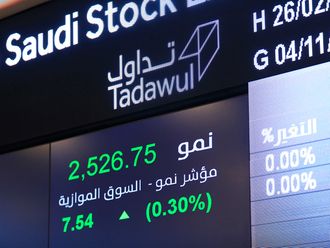After a bout of consolidation shares in India should rally to another record high in the coming week, in anticipation of growth-oriented policy moves by the new administration in New Delhi and supported by signs of green shoots in the economy.
Narendra Modi, who was sworn in as prime minister last week after he won a resounding victory for the Bharatiya Janata Party-led alliance in general elections, is tipped to open up the economy further by raising foreign investment limits in insurance and online retail and allow greater play for private sector investment in defence.
The government is also expected to scrap retrospective taxes and take the lead to resolve disputes with foreign companies such as Vodafone, a move that would go a long way to calm the nerves of international investors. Also on the anvil are divestments of government holdings in state-run undertakings, including in banks.
A clearer picture would be known on Monday when President Pranab Mukherjee delivers his address to the new parliament, laying out the government’s broad plan for reviving economic growth that has plummeted to below 5 per cent from more than 9 per cent until 4 years ago.
“The feel-good sentiment sweeping across the country has given a shot in the arm to business and investor confidence,” said equity salesman Anmol Bhushan. “Even the central bank has toned down its hawkish stance and there is optimism in the air.”
Interest rates
While holding interest rates as expected, the Reserve Bank of India (RBI) acknowledged that the decisive election verdict should “create a conducive environment for comprehensive policy actions”, an held out the hope for a reduction in borrowing costs if price pressures ease off more than expected.
“Easing of domestic supply bottlenecks and progress in the implementation of stalled projects should brighten the outlook for both manufacturing and services,” RBI Governor Raghuram Rajan said in a statement.
“If the economy stays on this course, further policy tightening will not be warranted. On the other hand, if disinflation, adjusting for base effects, is faster than currently anticipated, it will provide headroom for an easing of the policy stance,” he said.
Tushar Poddar, India economist at Goldman Sachs, who termed the overall tone on inflation as “not hawkish”, however, believes the RBI may have to tighten policy if price pressures build up.
“While the policy statement reduces the probability of further rate hikes by the RBI, we think that there are upside risks to the RBI’s inflation trajectory for 2014-15, due to entrenched inflation expectations, still-loose fiscal policy, and risks of a below normal monsoon,” he said. “We continue to expect 50 basis points of rate hikes in the repo rate in the remainder of 2014.”
Grab opportunity
Foreign investors have poured nearly $8.5 billion into Indian equities since the start of January, and almost an equivalent amount into debt securities, with the inflows picking up steam in May as a victory for the business-friendly Modi appeared imminent. There is a strong likelihood of the foreign demand to quadruple in the coming months.
In a little over a week’s time two companies, Yes Bank and Idea Cellular, have raised a combined $1 billion through institutional placement of shares, mostly foreign funds. Even property firm DLF, which has been going through a lean patch, was able to raise funds without any problem, thanks to the dramatic change in investor sentiment.
“It is a little unfair for people to seek out short-term returns right now,” Ridham Desai, head of India equity research at Morgan Stanley, told ET Now television channel. “We may be at the beginning of a multi-year bull market.”
He said investors should shed the “trading instinct” which would have worked in the past 3-4 years when the market was doing 20 per cent move either way, and look for a longer term horizon.
“I think timing the market now can be quite expensive. In that you could miss out in big market rallies and a big wealth creation opportunity,” Desai said.
The top-30 Sensex and the broader 50-share Nifty climbed to record highs of 25,419.14 and 7,592.70 respectively on Friday, and both the indices are set to extend the rise in the coming week. The Sensex closed at 25,396.46 and Nifty ended at 7,583.40, gaining 4.9 per cent on the week, adding to the 8 per cent rise in May.
“We remain confident that India’s new government will deliver on its economic agenda, which should in turn drive equity returns. Reiterate December Sensex target of 28,000,” Deutsche Bank said.
Mid-cap stocks
As the new government gets down to the task of rebuilding the bruised economy, investors would do well to keep an eye on mid-cap shares, which tend to outperform the big boys when a recovery starts to roll.
There has been a change in investor perception that now sees risks as opportunities. The move away from “defensives” is a clear sign that optimism runs deep about the new dispensation in New Delhi.
“Low growth in cyclical sectors is now a supportive base for a higher growth ahead. These hopes may become a reality if policy actions manage to meet or exceed investor expectations,” said JP Morgan.
“Mid-caps tend to outperform large caps early in the recovery cycle, as the outperformance is primarily linked to the convergence in valuations. Large cap benefits more from the real economic revival, both from financial and operating leverage perspectives. Valuation gap of the BSE mid-cap index has narrowed significantly. The trend herein will also be a function of recovery ahead, in our view,” the US investment bank said.
“It’s clear that investors across the world are searching for interesting mid-caps. The reasons vary by market, but one common theme seems to be over-ownership of large cap front line stocks,” added Manishi Raychaudhuri at BNP Paribas.
Valuations
In India, he said, 87 per cent of all foreign fund investment was in the top-100 stocks by market capitalisation, and these 100 stocks account for 81 per cent of total market capitalisation.
“At present, only in India and Indonesia are mid-caps trading below large caps. However, in all markets, the valuations of mid-caps in relation to large caps are above long-term averages — only in China has a significant mean reversion happened,” he said.
Among the Indian mid-cap stocks the brokerage favours were: Persistent Systems, IPCA Laboratories, Alembic Pharmaceuticals, Rallis India and Kaveri Seed.
The writer is a journalist based in India.












